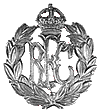
Captain Albert Ball |

|
Ball was the first British ace idolized by the public. An engineering student when the war began, he joined the Sherwood Foresters before transferring to the Royal Flying Corps in 1915. Described as an "introspective little chap," Ball was a loner with strong religious convictions who soon established a reputation as a fearless pilot and excellent marksman. On 22 August 1916, he scored his eleventh victory when he shot down Wilhelm Cymera's two-seater. In just three months over the Somme, he scored his first thirty victories. With the introduction of the S.E.5, he reluctantly gave up his Nieuport 17. Flying the new scout, Ball's patrol encountered Jasta 11 on 7 May 1917. In the confusion that followed, he and Lothar von Richtofen both crashed. Ball was killed but the German survived. Ball was listed as missing in action and it was several years before the details of his death were known. Evidence suggests Ball may have crashed due to pilot error, but Germany credited Richthofen with shooting down Great Britain's leading ace. His death disheartened the entire Royal Flying Corps |
"For most conspicuous and consistent bravery, from 25 April to 6 May 1917, during which period Captain Ball took part in twenty-six combats in the air and destroyed eleven hostile aeroplanes, drove down two out of control and forced several others to land. Flying alone, on one occasion he fought six hostile machines, twice he fought five and once four. When leading two other British planes, he attacked an enemy formation of eight. On each of these occasions he brought down at least one enemy plane and several times his plane was badly damaged. On returning with a damaged plane, he had always to be restrained from immediately going out in another." VC citation, London Gazette, 3 June 1917 |